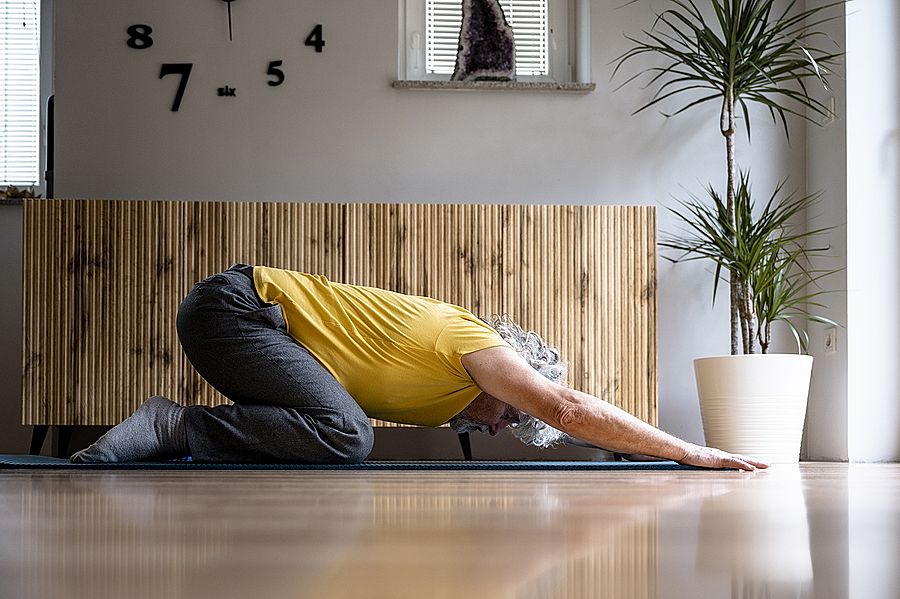
Sciatica pain is a common condition that affects many people. It is caused by compression or irritation of the sciatic nerve, the longest nerve in the body. This nerve runs from the lower back down to the feet, and its compression can cause sharp, shooting pain, numbness, tingling, and weakness in the lower back, hips, and legs. While medical treatment may be necessary in severe cases, sciatica treatment at home can help alleviate symptoms and provide relief. At The Institute for Comprehensive Spine Care, we strongly believe in the benefits of preventive care and the following can be done in the comfort of your home to help reduce the pain caused by sciatica.
The knee-to-chest stretch is a classic exercise that helps to relieve pressure on the sciatic nerve and alleviate pain. To perform this stretch, lie on your back and bring one knee towards your chest. Hold for 30 seconds and then switch legs. Repeat 2-3 times on each side.
The Figure 4 stretch targets the piriformis muscle, located in the buttocks near the top of the hip joint. It is involved in hip movement and serves as an external rotator of the hip joint and can contribute to sciatica pain when tight or inflamed. To perform this stretch, lie on your back with your knees bent and feet flat on the ground. Cross one ankle over the opposite knee, then gently pull the knee towards your chest. Hold for 30 seconds and then switch legs. Repeat 2-3 times on each side.
The seated spinal twist can help to relieve tension in the lower back and hips. To perform this stretch, sit on the floor with your legs extended in front of you. Bend one knee and place the foot on the outside of the opposite knee. Place your hand on the ground behind you and twist your torso towards the bent knee. Hold for 30 seconds and then switch sides. Repeat 2-3 times on each side.
The child's pose is a gentle stretch that can help to relieve tension in the lower back and hips, reducing the risk of sciatica pain. To perform this stretch, start on your hands and knees. Sit back onto your heels and reach your arms forward. Hold for 30 seconds.
The pelvic tilt can help to stretch the lower back muscles and alleviate sciatica pain. To perform this stretch, lie on your back with your knees bent and feet flat on the ground. Tighten your abdominal muscles and press your lower back into the ground. Hold for 5 seconds and then release. Repeat 10-15 times.
Tight hamstrings can contribute to sciatica pain by pulling on the pelvis and lower back. To perform this stretch, lie on your back with your knees bent and feet flat on the ground. Lift one leg and straighten it, keeping the other leg bent. Place your hands behind the thigh and gently pull the leg towards you. Hold for 30 seconds and then switch legs. Repeat 2-3 times on each side.
To perform this stretch, lie on your stomach with your hands under your shoulders. Press your hands into the ground and lift your upper body, keeping your hips on the ground. Hold for 30 seconds.

Maintaining a healthy weight is essential for overall health and can play a crucial role in sciatica treatment at home. Excess weight can put a strain on the spine and worsen existing nerve damage, leading to increased pain and discomfort. By maintaining a healthy weight, you can reduce pressure on your spine and minimize the risk of further nerve damage, resulting in reduced pain and improved quality of life.
Obesity is a significant risk factor for developing sciatica. Eating a diet rich in fruits, vegetables, whole grains, and lean protein while limiting processed foods, sugar, and saturated fat can help maintain a healthy weight.
Sciatic pain can be debilitating and negatively impact an individual's quality of life. Stress is known to exacerbate pain symptoms, and incorporating stress-reducing techniques is a great way to have sciatica treatment at home. Here are some sciatica treatment at home techniques that can help:
Deep breathing exercises can reduce stress and promote relaxation, which can help alleviate sciatic pain. Inhale deeply through the nose, hold your breath for a few seconds, and then exhale slowly through your mouth. Repeat for several minutes.
Gentle yoga stretches can help by improving flexibility and reducing muscle tension. Some yoga poses like the downward-facing dog, pigeon, and cobra poses can be beneficial for alleviating sciatic pain.
Meditation is an effective stress-reducing technique. It involves focusing on the breath and clearing the mind of distracting thoughts. Regular meditation practice can help reduce stress, promote relaxation, and alleviate pain symptoms.
Massage therapy can be helpful in reducing muscle tension and improving circulation, leading to reduced pain and improved mobility. Gentle massage techniques can be used to target the affected area and provide relief.
Applying heat or cold to the affected area can help reduce inflammation and relieve pain. Use a heating pad to apply heat to your lower back for 15-20 minutes at a time. You can use an ice pack or a bag of frozen peas wrapped in a towel to do the same for cold.
Sciatic treatment at home also includes making sure that you have good posture. Poor posture can cause muscle imbalances, leading to further damage and increasing pain. When sitting, it is important to keep the back straight, the feet flat on the ground, and the shoulders relaxed. A slouched position can cause strain on the lower back, which can exacerbate sciatic pain. Standing up every 15-30 minutes and walking around can help relieve pressure on the back and prevent muscle imbalances from occurring. An ergonomic chair can also be beneficial in supporting the lower back and promoting good posture.
Additionally, poor posture during sleep can worsen sciatica pain. Sleeping on a mattress that provides support for the spine's natural curve can help prevent further damage to the back. The mattress should also support the hips and shoulders, allowing the spine to maintain a neutral position during sleep. A pillow that keeps the neck aligned with the spine can also be beneficial in maintaining good posture during sleep. Sleeping on the stomach should be avoided as it can cause strain on the lower back and lead to further damage.

However, if the above-mentioned techniques are not providing relief and you are experiencing severe sciatica pain, contact us to schedule a consultation. As a highly accredited medical professional with over 20 years of experience in treating spinal conditions such as sciatic pain, I am committed to educating my patients and providing personalized treatment plans that reduce pain, increase mobility, and improve their overall quality of life.
At The Institute for Comprehensive Spine Care, our personalized approach to care and commitment to patient education provide you with the best possible care for your spinal condition and can help you live pain-free.